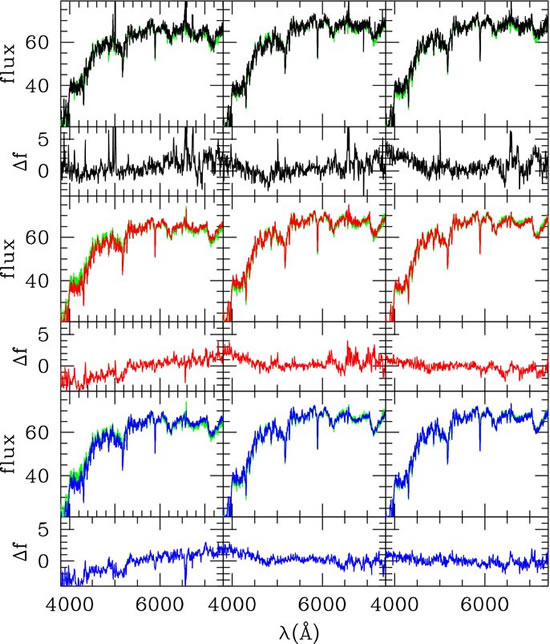Research Gallery > Extragalactic Astronomy
Research Gallery
Extragalactic Astronomy
| On the Populations of Radio Galaxies with Extended Morphology at z < 0.3 |
|
Image Credit: Yen-Ting Lin et al.

Mean SDSS spectra of RGs of different morphologies and different SMBH masses. From left to right, the columns are of increasing ranges of SMBH mass. Within each column, the top two panels show the mean spectrum of lobe-dominated objects with "hot spots" and optical nuclear mission lines (type A, black curve) and its difference from the radio quiet (RQ) galaxies that have the same SMBH mass and galactic structures (green curve, repeated in other panels in a column). The two panels in the middle are for lobe-dominated RGs without "hot spots" (type B, red
curve); the bottom two are for RGs with prominent jets close to the nucleus (type C, blue curve). It is interesting to see in the lower left corner of the figure, for the low mass RGs of type B & C, their mean spectra are redder compared to the RQ counterparts, and lack the Hα emission line, which may be an evidence of feedback from the radio lobes that shutdown the star formation activities.
|
| Supermassive blackholes (SMBHs) are believed to play an important role in the evolution of galaxies. In particular, the "radio loud" phase during which accretion onto the SMBH results in prodigious outflow of high energy particles is expected to maintain low star formation rates in massive elliptical galaxies. Yen-Ting Lin and collaborators have carried out a comprehensive study of properties of radio galaxies (RGs) in the nearby Universe. They have proposed a new, objective scheme of classification that allows distinct populations of RGs to be identified, which represents an improvement over the classical Fanaroff-Riley (1974) scheme. They suggested that the accretion rates onto the SMBH is the key factor in the formation of three main classes of RGs they identified; from lobe-dominated sources with "hot spots" and optical nuclear emission lines (type A), to lobe-dominated sources without optical nuclear emission lines (type B), to sources with prominent jets close to the nucleus (type C), the accretion rates decreases. They also suggested that these RGs of different radio morphologies would have different effects on the host galaxies and surrounding environment. The powerful jets from lobe-dominated sources with "hot spots" (type A) could easily penetrate the host galaxy and affect intergalactic/intracluster medium up to scales of hundreds of kpc. On the other hand, the less powerful jets from the other two classes of RGs (type B & C) would have larger cross sections within the host galaxy, and therefore may be quite effective in shutting down star formation activity that may be linked to
whatever mechanism that initiated the nuclear SMBH activity. |
 asiaa.sinica.edu.tw Media Request: epo
asiaa.sinica.edu.tw Media Request: epo asiaa.sinica.edu.tw
asiaa.sinica.edu.tw 
